Description
Advanced Filtration in Hygienic Air Handling Units
Advanced filtration is a key feature of hygienic air handling units (AHUs) that distinguishes them from conventional AHUs. Hygienic AHUs are equipped with advanced filters capable of removing particulate matter, pollutants, and bacteria from the air more effectively.
Types of advanced filters in hygienic AHUs
Primary filter
A primary filter prevents large particles such as dust from entering the air purifier. It is usually made of a wire mesh or a layer of fabric. The primary filter is usually located at the air intake of the air purifier.
Secondary filter
The secondary filter removes smaller particles such as fine dust, smoke, and hair from the air. It is usually made of a layer of paper or a layer of fabric. The secondary filter is usually located at the air outlet of the air purifier.
HEPA filter
A HEPA filter can remove airborne particles down to 0.3 microns in size. It can remove bacteria, viruses, and other small pollutants from the air. A HEPA filter is usually made of a layer of paper that is coated with a layer of fiberglass.
ULPA filter
A ULPA filter can remove airborne particles down to 0.12 microns in size. It can even remove very small airborne particles such as bacteria and viruses from the air. A ULPA filter is usually made of a layer of paper that is coated with a layer of very fine fiberglass.
Hygienic air purifiers with advanced filtration
Hygienic air purifiers with advanced filtration can be suitable for environments that require clean and healthy air, such as hospitals, clinics, laboratories, and the food industry.
Controlled Hygienic Air Handling Unit (AHU) Ventilation System
A Controlled Hygienic Air Handling Unit (AHU) Ventilation System is a type of HVAC system designed to provide clean and healthy air in sensitive environments. It has specific features that distinguish it from conventional HVAC systems, including:
Precise Control of Temperature, Humidity, and Air Quality
Hygienic Air Handling Unit Controlled Ventilation Systems use a variety of equipment and controllers to precisely control temperature, humidity, and air quality. This equipment and these controllers can control temperature, humidity, and air quality more precisely than conventional HVAC systems.
Use of Advanced Filters
Hygienic AHU Controlled Ventilation Systems use advanced filters such as HEPA filters and ULPA filters, which can effectively remove particulate matter, pollutants, and bacteria from the air. These filters can remove particulate matter down to a size of 0.3 microns from the air.
Hygienic Design
Hygienic AHU Controlled Ventilation Systems have a more hygienic design that makes them easier to clean and maintain. This design includes the use of antimicrobial materials and the ability to easily disassemble components for cleaning.
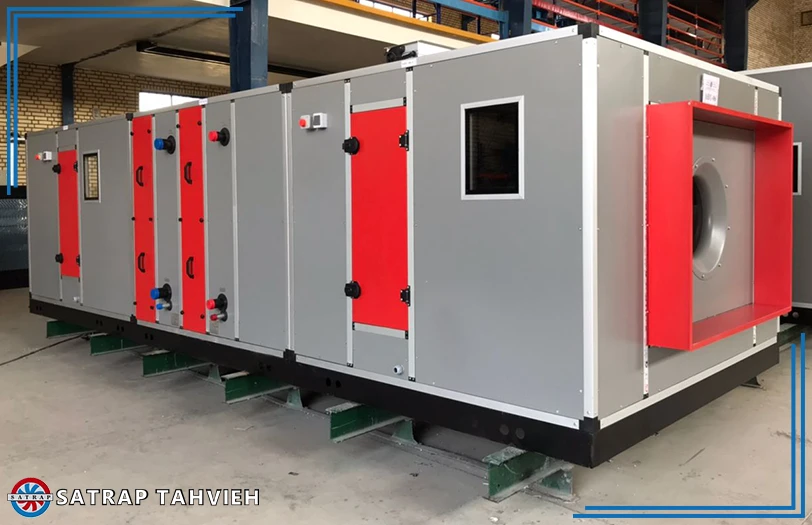
Advantages of a Controlled Hygienic Air Handling Unit Air Conditioning System
Some of the advantages of using a controlled air conditioning system include:
- Preservation of people’s health: Clean and healthy air can help to preserve people’s health and prevent the spread of diseases.
- Creating a safe and hygienic environment: The controlled hygienic air handling unit air conditioning system can help to create a safe and hygienic environment for people.
The controlled hygienic air handling unit air conditioning system is an advanced air conditioning system that can help to improve air quality and preserve people’s health. This system is suitable for environments that require clean and healthy air.
The hygienic design
The hygienic design of the Hygienic AHU makes it easier to clean and maintain. This design includes the use of antimicrobial materials and the ability to easily disassemble components for cleaning.
Antimicrobial Materials
This air purifier is made with antimicrobial materials such as stainless steel and ABS plastic. These materials do not promote the growth of bacteria and fungi.
Easy-to-Disassemble Parts
Its internal components are designed to be easily disassembled and cleaned. This facilitates regular cleaning and maintenance of the air purifier.
Advantages of Hygienic Air Handling Units
Some of the advantages of using hygienic air handling units include:
Production of clean and healthy air
This product has advanced filters that can more effectively remove particulate matter, pollutants, and bacteria from the air. These filters can more effectively remove airborne pollutants such as dust, smoke, bacteria, and viruses from the air.
Preserving people’s health
Clean and healthy air can help maintain people’s health and prevent the spread of disease. Clean air can help improve lung function, reduce the risk of heart and vascular disease, and increase life expectancy.
Creating a safe and sanitary environment
Hygienic air handling units can help create a safe and sanitary environment for people. Clean and healthy air can help reduce stress, increase productivity, and improve quality of life.
Hygienic air handling units are suitable for environments that require clean and healthy air. These air handling units can help maintain people’s health and prevent the spread of disease.
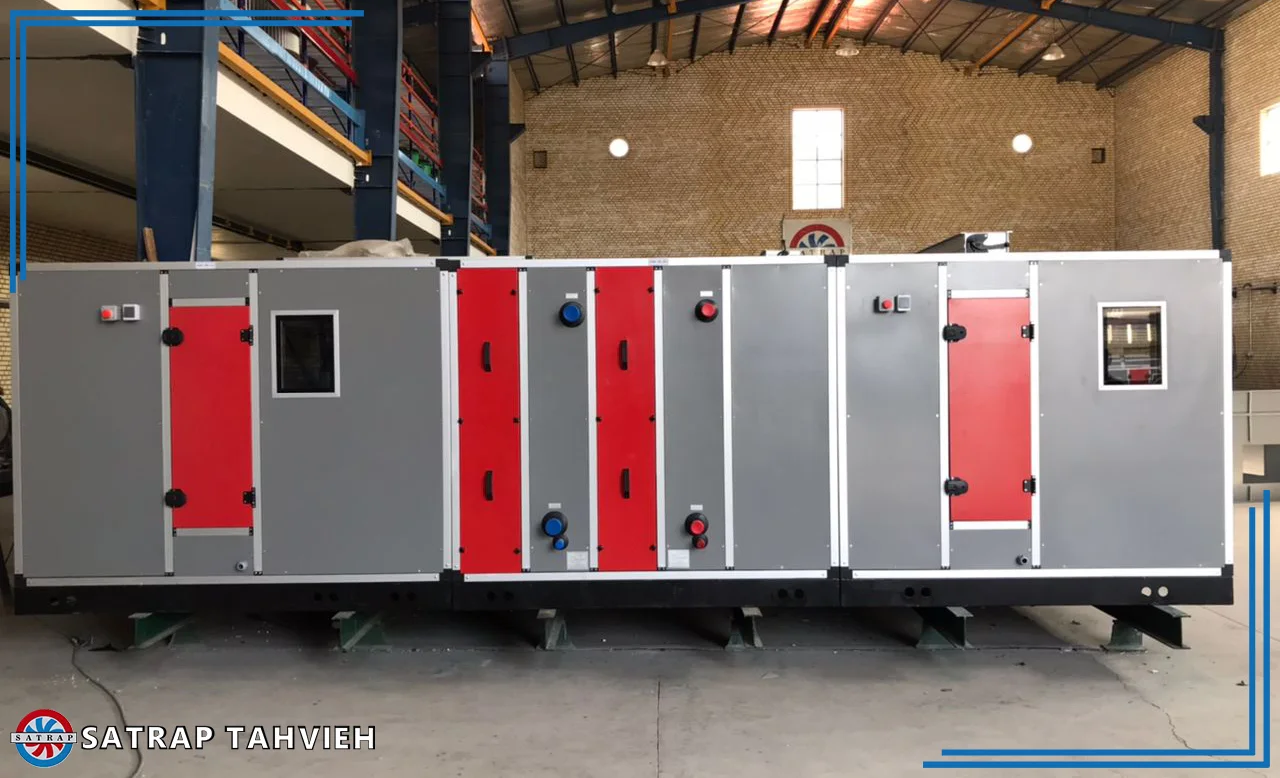
Differences Between Hygienic and Conventional Air Handling Units
Hygienic and conventional air handling units are two types of HVAC systems used to provide clean and cool air in enclosed spaces. The main difference between these two products lies in the level of air filtration and purification.
Hygienic air handling units
- Utilize advanced filters to eliminate fine particles, dust, microbes, and unpleasant odors from the air.
- Equipped with a humidity and temperature control system that adjusts the amount of water and heat in the air, creating a more comfortable environment for lung and skin health.
Conventional air handling units
- Usually only have a dust filter and do not have sufficient air purification capabilities.
- Primarily designed for space cooling and cannot maintain proper humidity and temperature levels.
When choosing an air handling unit for your workplace or home, it is important to consider the advantages and disadvantages of both types and select the appropriate option based on your needs and budget.
The Hygienic Air Handling Unit (AHU) air conditioning system is responsible for controlling temperature, humidity, and air quality. This system can help maintain a comfortable temperature, ideal humidity, and healthy air quality in an environment.
Hygienic Design of Hygienic Air Handling Units
The hygienic design of a hygienic air handling unit (AHU) is crucial to ensure its cleanliness and maintainability. This design involves the use of antimicrobial materials and the easy disassembly of components for cleaning.
building a hygienic air handling unit (AHU)
The process of building a hygienic air handling unit (AHU) can be summarized in the following steps:
1. Design: The first step is to design the hygienic AHU. This includes determining the technical specifications of the AHU, such as its capacity, filter type, ventilation system, and hygienic design.
2. Procurement of components: After the design is finalized, the necessary components for building the AHU are procured. These components include filters, fans, and other equipment.
3. Assembly: In this stage, the components of the AHU are assembled based on the specified design.
4. Testing: After assembly, the AHU must be tested to ensure its proper functioning.
5. Installation: In the final step, the AHU is installed at the desired location.
The cost of building a hygienic air handling unit (AHU)
The cost of building a hygienic air handling unit (AHU) depends on various factors, including capacity, type of filters, HVAC system, and hygienic design. In general, the cost of building a hygienic AHU is higher than a conventional AHU.
How Hygienic Air Handling Units Work
1. Air Intake:
- Air enters the air handling unit through air ducts.
2. Filtration:
- The air passes through various filters to remove particulate matter, pollutants, and bacteria.
3. Heating or Cooling:
- The air is heated or cooled depending on the environmental requirements.
4. Dehumidification or Humidification:
- The air’s humidity is adjusted based on the needs of the environment.
5. Air Distribution:
- The air is distributed to the environment through air ducts.
The body of the hygienic air handling unit
The body of the hygienic air handling unit is of particular importance, as it must be able to protect the advanced filters used in this air handling unit. The body of the hygienic air handling unit is usually made of antimicrobial and anti-corrosion materials.
The housing material of a hygienic air purifier is usually made of one of the following materials:
Stainless steel: Stainless steel is a corrosion-resistant material that can protect the filters of a hygienic air purifier.
Aluminum: Aluminum is a lightweight and durable material that can protect the filters of a hygienic air purifier.
Polymers: Polymers are materials that can be resistant to corrosion and wear.
Features of Hygienic Air Handling Unit Casing:
The casing of a hygienic air handling unit (AHU) must possess the following characteristics:
- Antimicrobial: The casing should prevent the growth of microorganisms.
- Anti-corrosive: The casing should be resistant to corrosion.
- Wear-resistant: The casing should be resistant to abrasion.
- Easy to disassemble: The casing should be designed for easy disassembly for cleaning.
Types of Hygienic Air Handling Unit (AHU) Casings
The casing of a hygienic AHU is a crucial component that must be of high quality. It should be made of anti-microbial and anti-corrosive materials and possess the necessary features to protect the AHU’s filters.
There are two main types of hygienic AHU casings:
1. Single-piece casing:
- A single-piece casing is a single unit made of stainless steel or aluminum.
- It offers a seamless and hygienic design, minimizing the risk of microbial growth and contamination.
- Single-piece casings are easier to clean and maintain, reducing downtime and operational costs.
2. Multi-piece casing:
- A multi-piece casing is constructed from several individual panels that are joined together.
- It provides flexibility in terms of design and installation, allowing for customization to specific requirements.
- Multi-piece casings may be more cost-effective than single-piece casings for larger AHUs.
Types of Hygienic Air Handling Units
Hygienic air handling units (AHUs) are classified into two main categories:
Central Hygienic AHUs
Central hygienic AHUs are advanced ventilation systems designed to provide clean and healthy air in large spaces. These AHUs are typically used in hospitals, laboratories, food industries, and other environments that require clean and healthy air.
Ceiling Hygienic AHUs
Ceiling hygienic AHUs are advanced ventilation systems designed to provide clean and healthy air in small to medium-sized spaces. These AHUs are typically used in operating rooms, patient rooms, and other environments that require clean and healthy air.
Coils in Hygienic Air Handling Units
Coils are one of the main components of hygienic air handling units (AHUs) responsible for heating or cooling the air. They are usually made of copper or aluminum and have a finned surface that increases the heat transfer area.
Types of Coils in Hygienic AHUs
There are two types of coils in hygienic AHUs:
Heating Coil
The heating coil uses hot water or steam to heat the air. The hot water or steam flows through the coil tubes, warming the air.
Cooling Coil
The cooling coil uses chilled water or refrigerant to cool the air. The chilled water or refrigerant flows through the coil tubes, cooling the air.
Features of Coils in Hygienic AHUs
Coils in hygienic AHUs must have the following features:
- Corrosion resistance: The coils must be resistant to corrosion to prevent damage over time.
- Anti-fouling: The coils must be resistant to fouling to maintain their performance.
- Leak-proof: The coils must be leak-proof to prevent water or refrigerant leaks.
Technical Specifications of Hygienic AHUs
The technical specifications of hygienic AHUs include:
- Airflow capacity: The airflow capacity of a hygienic AHU is the amount of air it can move in and out of a space per unit time. The airflow capacity should be proportional to the size of the space.
- Filter type: Hygienic AHUs have various types of filters that can remove particulate matter, pollutants, and bacteria from the air. The filter type should be appropriate for the level of air pollution in the environment.
- HVAC system type: Hygienic AHUs have different types of HVAC systems that can maintain the ambient temperature at a comfortable level. The HVAC system type should be suitable for the needs of the space.
- Coil type: Hygienic AHUs have various types of coils that can heat or cool the air. The coil type should match the type of HVAC system in the AHU.
- Casing material: Hygienic AHUs are typically made of stainless steel or aluminum. The casing material should be suitable for the environmental conditions.
- Other specifications: Other specifications of hygienic AHUs include size, weight, noise level, and energy consumption.
Selecting a Hygienic Air Handling Unit
Selecting the right hygienic air handling unit (AHU) requires considering various factors. Some of these factors include:
International Standards for Hygienic Air Handling Units
There are various international standards that define the technical specifications for hygienic air handling units. Some of the most important standards include:
ASHRAE Standard 62.1-2019
This standard specifies the technical requirements for hygienic air handling units in residential and commercial environments.
ASHRAE Standard 110-2020
This standard specifies the technical requirements for hygienic air handling units in hospitals and healthcare settings.
ISO 16890-1:2016
This standard specifies the technical requirements for air filters.
Hygienic Air Handling Units: Users and Standards
Hygienic air handling units (AHUs) are used in a wide range of environments due to their ability to produce clean and healthy air. Some of the most important users of hygienic AHUs include:
- Hospitals and healthcare facilities: Hygienic AHUs are used in hospitals and healthcare facilities to create a safe and sanitary environment for patients and staff.
- Laboratories: Hygienic AHUs are used in laboratories to prevent the spread of contamination and pollutants.
- Food and pharmaceutical industries: Hygienic AHUs are used in the food and pharmaceutical industries to produce high-quality and safe products.
- Residential and office environments: Hygienic AHUs are used in residential and office environments to improve air quality and increase productivity.
Hygienic AHUs must meet certain standards to be able to provide clean and healthy air in the environment. Some of the most important standards for hygienic AHUs include:
- ASHRAE Standard 62.1-2019: This standard specifies the technical requirements for hygienic AHUs in residential and office environments.
- ASHRAE Standard 110-2020: This standard specifies the technical requirements for hygienic AHUs in hospital and healthcare environments.
- ISO Standard 16890-1:2016: This standard specifies the technical requirements for air filters.
ASHRAE Standard 62.1-2019 specifies the technical requirements for hygienic AHUs in residential and office environments. This standard includes the following:
- Airflow capacity: The airflow capacity of the AHU must be appropriate for the size of the environment.
- Filter type: The AHU must have filters that can remove particulate matter, pollutants, and bacteria from the air.
- Type of HVAC system: The AHU must have an HVAC system that can keep the ambient air at the desired temperature.
- Body material: The body of the AHU must be made of antimicrobial and anti-corrosion materials.
ASHRAE Standard 110-2020 specifies the technical requirements for hygienic AHUs in hospital and healthcare environments. This standard includes the following:
- Airflow capacity: The airflow capacity of the AHU must be appropriate for the size of the environment.
- Filter type: The AHU must have filters that can remove particulate matter, pollutants, and bacteria from the air.
- Type of HVAC system: The AHU must have an HVAC system that can keep the ambient air at the desired temperature.
- Body material: The body of the AHU must be made of antimicrobial and anti-corrosion materials.
- Heat transfer coefficient of the AHU: The heat transfer coefficient of the AHU must be high to be able to heat or cool the ambient air quickly.
- Air leakage rate from the AHU: The air leakage rate from the AHU must be low to prevent the spread of contamination and pollutants.
ISO Standard 16890-1:2016 specifies the technical requirements for air filters. This standard includes the following:
- Filter type: ISO Standard 16890-1:2016 defines various types of air filters.
- Filtration efficiency: ISO Standard 16890-1:2016 determines the filtration efficiency of air filters.
- Technical specifications of filters: ISO Standard 16890-1:2016 specifies the technical specifications of air filters.
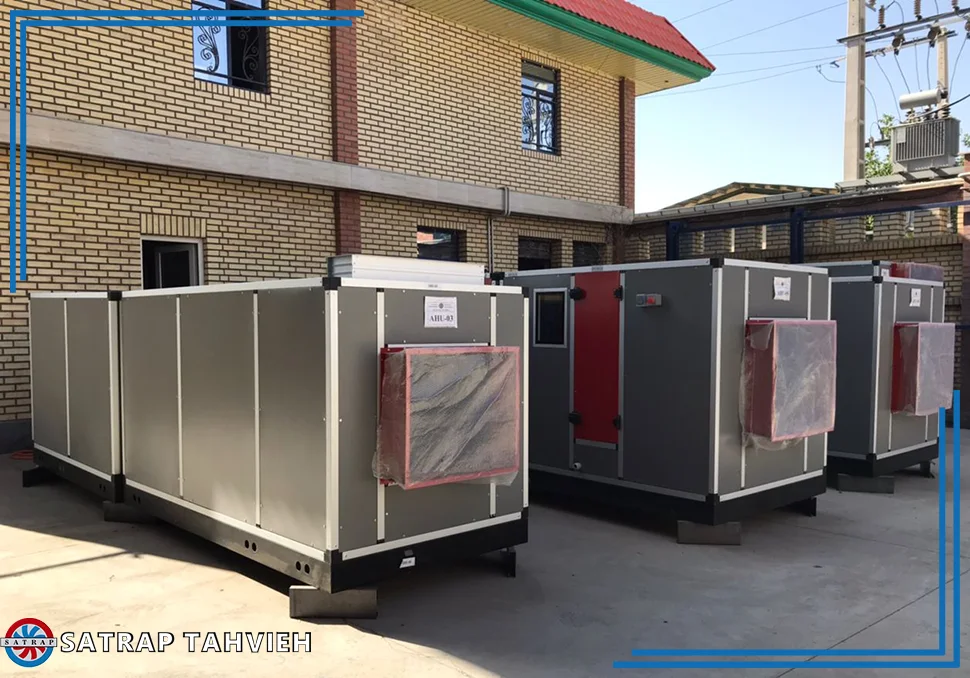
Hygienic Air Handling Units from Satrtapahvieh Alborz
Satraptahvieh Alborz is a designer and manufacturer of various types of air handling units for hospitals, cleanrooms, industrial and non-industrial hygienic or sanitary applications, and other cooling and heating systems in accordance with the latest standards and tailored to the specific needs of each project. All of our products are sold directly from the company’s factory after design and production, at a reasonable price.

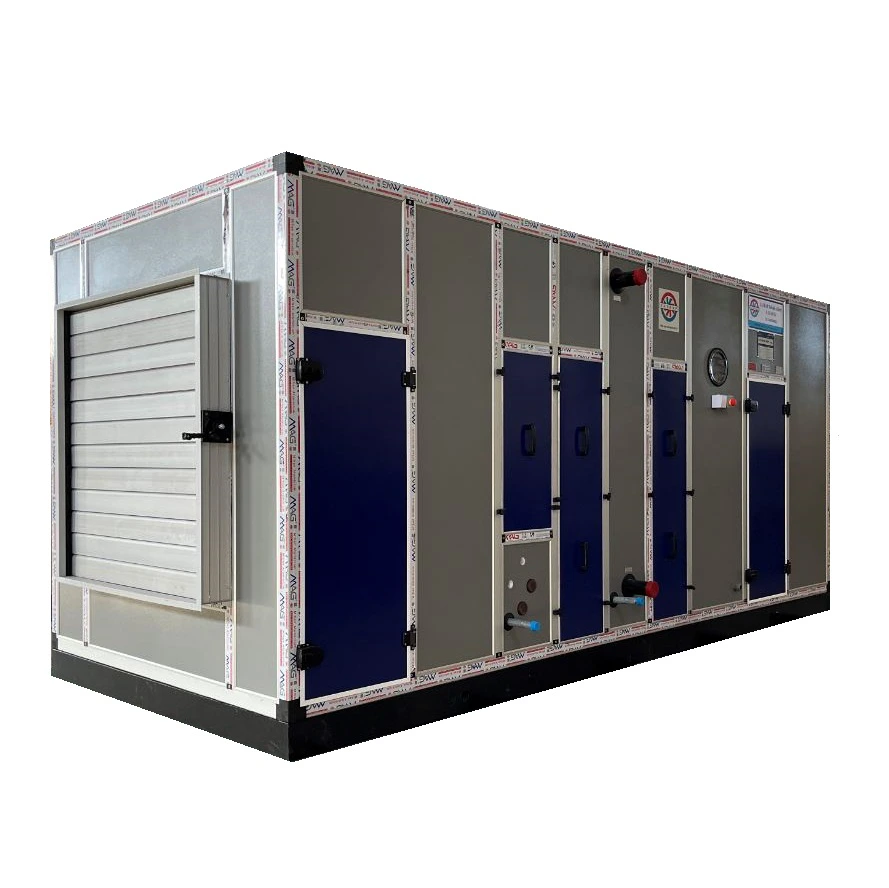
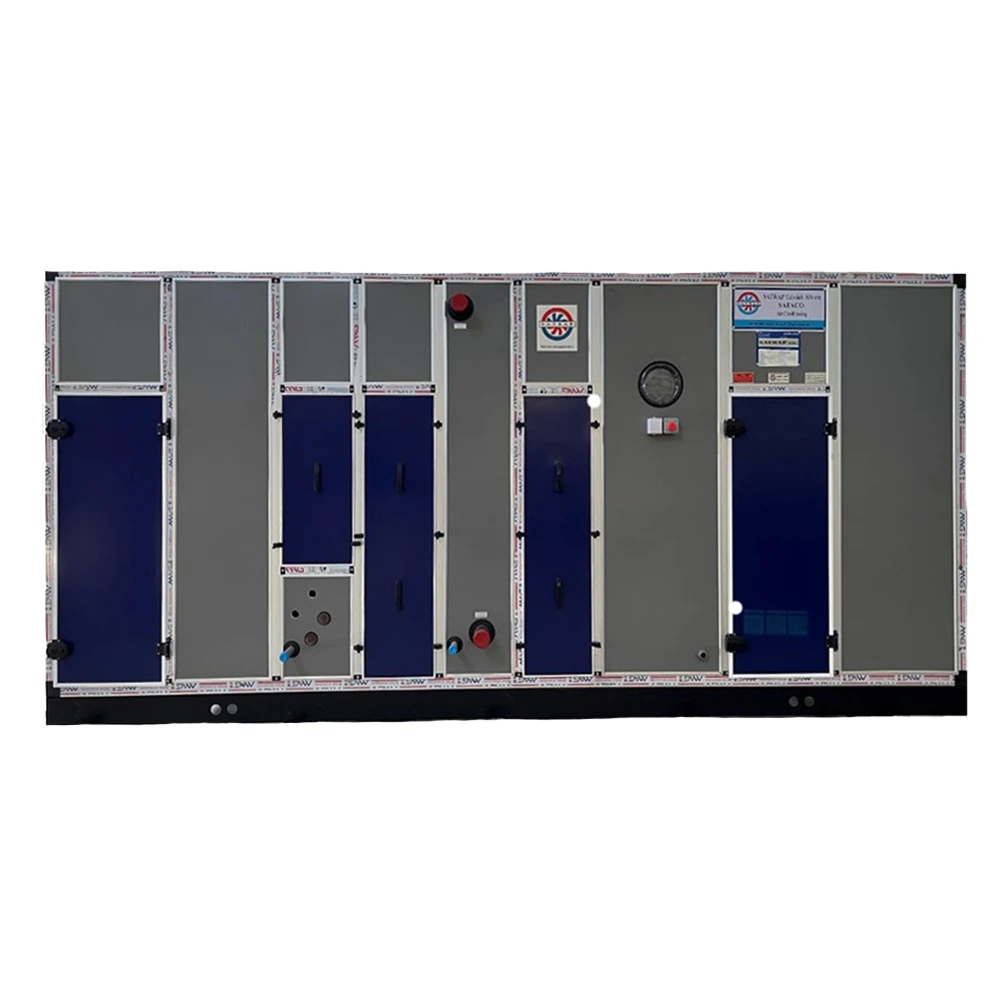

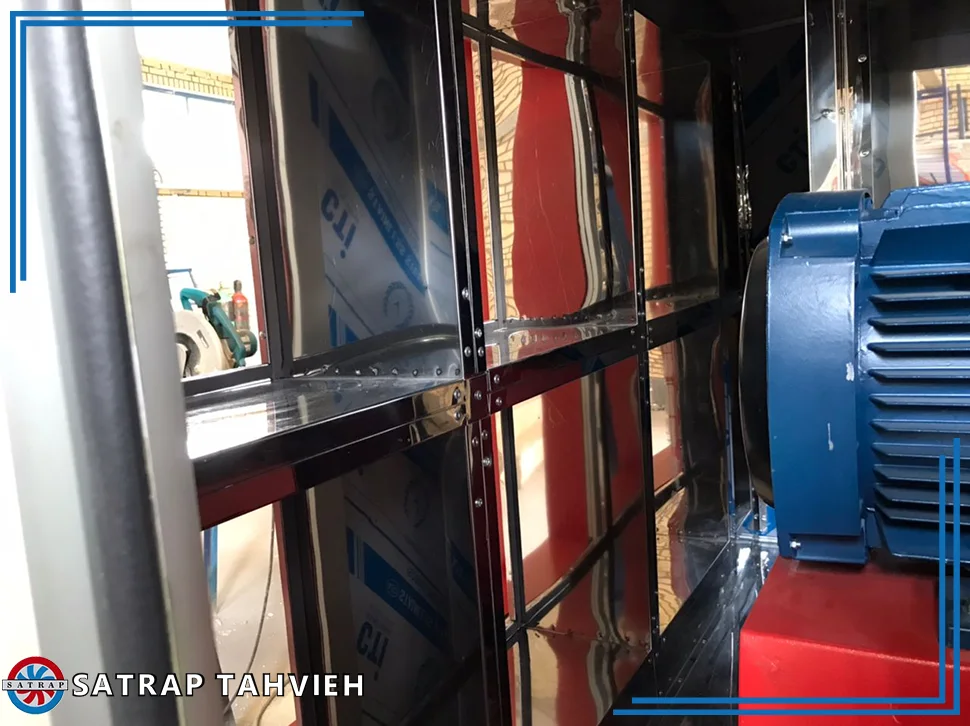
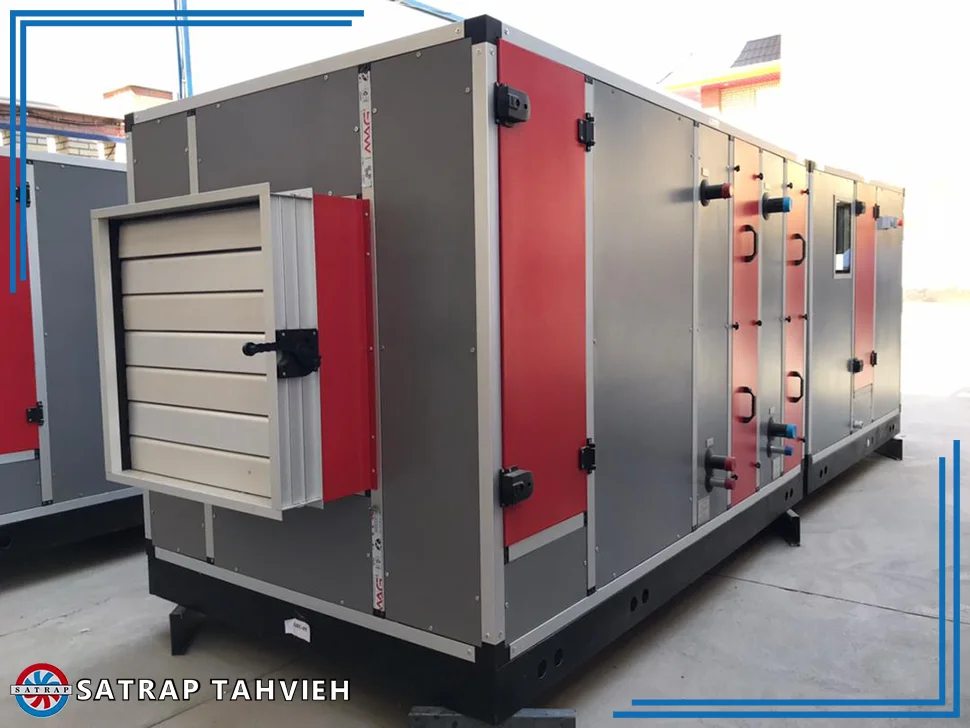
Reviews
There are no reviews yet.